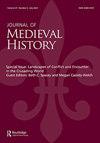漫长的九世纪的白话文:走向一段相连的历史
IF 0.2
2区 历史学
0 MEDIEVAL & RENAISSANCE STUDIES
引用次数: 0
摘要
摘要在八世纪末之前,除了少数例外(金石学、高加索和西北群岛的语言),欧洲几乎没有用拉丁语、希腊语和希伯来语以外的语言书写的文字。在漫长的九世纪里,“三种神圣语言”的垄断地位受到了动摇和挑战:几种白话语言(凯尔特语、日耳曼语和斯拉夫语,但也有浪漫主义,如果程度较低的话)首次出现在文字中,其他语言也以重要的方式发展。本文在介绍这期《九世纪长篇白话文》专刊时,首先对变革开始前的欧洲语言状况进行了评估;它继续总结了已知在漫长的九世纪发生的主要发展;然后,它解决了它们可能的联系和可观察到的纠缠,并确定了允许书面白话出现和持续繁荣的条件。本文章由计算机程序翻译,如有差异,请以英文原文为准。
Vernacular languages in the long ninth century: towards a connected history
ABSTRACT Before the late eighth century, with a few exceptions (epigraphy, the languages of the Caucasus and the North-Western Isles), little had been written in Europe in languages other than Latin, Greek and Hebrew. The long ninth century saw this monopoly of the ‘three sacred languages’ shaken and challenged: several vernacular languages (Celtic, Germanic and Slavonic, but also, if to a lesser extent, Romance) appeared in writing for the first time and others developed in significant ways. This paper, introducing this special issue on Vernacular Languages in the Long Ninth Century, starts with an assessment of the linguistic situation of Europe before the changes began; it goes on with a summary of the main developments known to have taken place in the long ninth century; it then addresses their possible connections and observable entanglements and identifies the conditions that allowed the emergence and the sustained flourishing of written vernaculars.
求助全文
通过发布文献求助,成功后即可免费获取论文全文。
去求助
来源期刊

JOURNAL OF MEDIEVAL HISTORY
MEDIEVAL & RENAISSANCE STUDIES-
CiteScore
0.60
自引率
0.00%
发文量
29
期刊介绍:
The Journal of Medieval History aims at meeting the need for a major international publication devoted to all aspects of the history of Europe in the Middle Ages. Each issue comprises around four or five articles on European history, including Britain and Ireland, between the fall of Rome and the Renaissance. The Journal also includes review articles, historiographical essays and state of research studies.
 求助内容:
求助内容: 应助结果提醒方式:
应助结果提醒方式:


